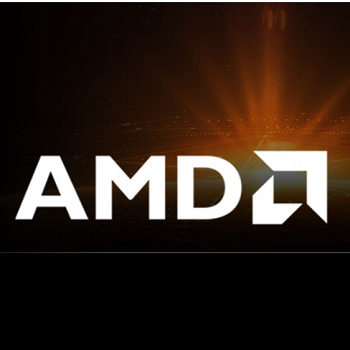Revenue for the quarter was up 52.3% from last year to $3.2 billion, GAAP profit was $1.8 billion, 948% from last year.
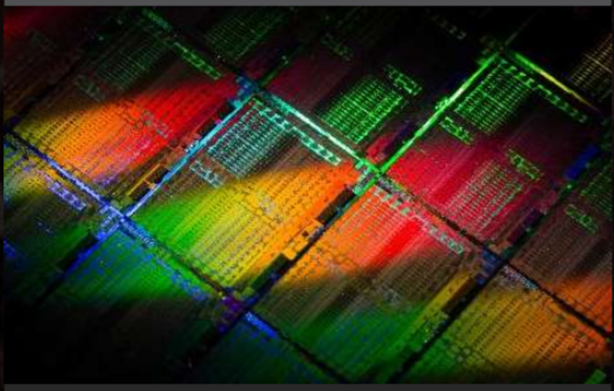
AMD announced its Q4’20 revenue hit $3.24 billion, with an operating income of $570 million, and a net income of $1.78 billion.
For the year 2020, the company reported revenue of $9.76 billion, operating income of $1.37 billion, and net income of $2.49 billion.
“We significantly accelerated our business in 2020, delivering record annual revenue while expanding gross margin and more than doubling net income from 2019,” said Dr. Lisa Su, AMD president, and CEO. “Our 2021 financial outlook highlights the strength of our product portfolio and robust demand for high-performance computing across the PC, gaming, and data center markets. We are excited about the opportunities ahead and very confident in our long-term strategy as we continue executing our leadership product roadmaps.”
The gross margin was 45%, up 2.3% from last quarter, and flat year-over-year. The year-over-year increase for the quarter was driven primarily by Ryzen and EPYC processor sales.
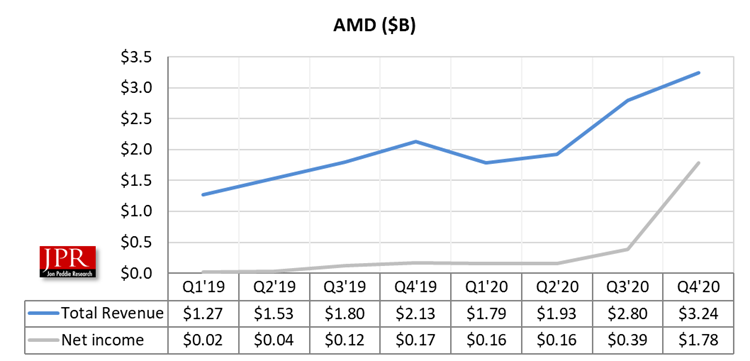
Operating income was $1.37 billion compared to $631 million in the prior year. The operating income improvement was primarily driven by higher revenue and gross margin expansion.
Net income was $1.78 billion, as compared to $170 million a year ago and $390 million in the prior quarter. Non-GAAP net income was $636 million compared to $383 million a year ago and $501 million in the prior quarter.
Graphics Group
Computing and Graphics segment revenue was $1.96 billion, up 18% year-over-year and quarter-over-quarter is primarily driven by strong sales of Ryzen processors.
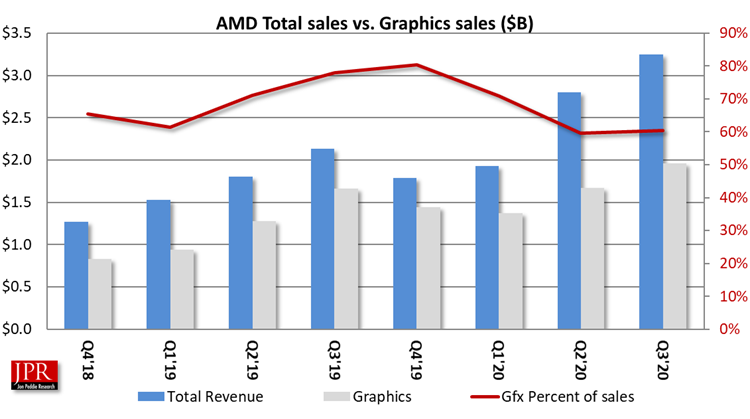
Client processor ASP was lower year-over-year due to a higher mix of Ryzen mobile processor sales. Client processor ASP was higher quarter-over-quarter driven by Ryzen desktop processor sales.
Radeon graphics product ASPs were higher year-over-year and quarter-over-quarter.
Enterprise, Embedded, and Semi-Custom
Enterprise, Embedded, and Semi-Custom segment revenue was $1.28 billion, up 176% year-over-year and 13% quarter-over-quarter driven by higher semi-custom and EPYC processor sales.
Operating income was $243 million compared to $45 million a year ago and $141 million in the prior quarter. Operating income improvements were primarily driven by higher revenue.
All Other operating loss was $93 million, including $14 million acquisition-related costs, as compared to operating losses of $57 million a year ago and $76 million in the prior quarter.
Margin
AMD has been steadily improving its gross margin, and this quarter it was up 2.3% over the last quarter.
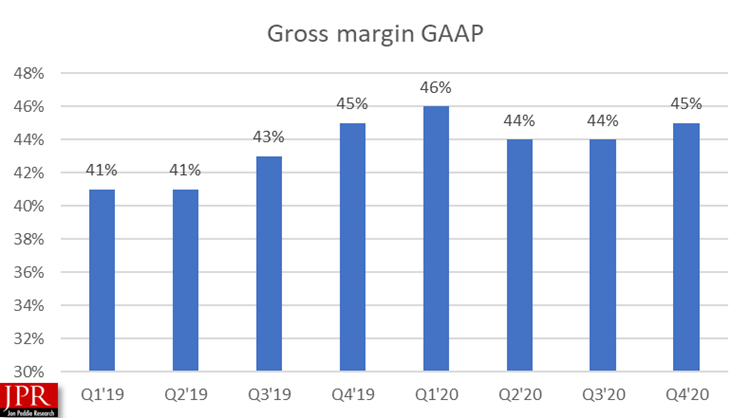
AMD launched the AMD Radeon RX 6000 Series of GPUs for next-generation PC gaming, including the fastest AMD gaming graphics card, the AMD Radeon RX 6900 XT GPU. The new AIBs are built upon AMD’s RDNA 2 gaming architecture, which the company claims delivers up to 2× higher performance and up to 54% higher performance-per-watt compared to Radeon graphics cards built on AMD RDNA architecture.
AMD continues to expand its position in the commercial and consumer client markets and growing adoption of its Ryzen processors by leading OEMs. The company said OEM partners launched new AMD-powered notebooks, desktops, and Chromebooks, including new HP and Lenovo notebooks and desktops.
The company announced new processors for laptops, the AMD Ryzen 5000 mobile processors with the Zen 3 core architecture. AMD says its Ryzen 5000 Series Mobile processors provide unprecedented performance and battery life.
Outlook
For the first quarter of 2021, AMD expects revenue to be approximately $3.2 billion, plus or minus $100 million, an increase of approximately 79% year-over-year and down 1% sequentially. The year-over-year increase is expected to be driven by growth in all businesses. AMD expects non-GAAP gross margin to be approximately 46% in the first quarter of 2021.
For the full year 2021, AMD expects revenue growth of approximately 37% over 2020 driven by growth in all businesses. AMD expects non-GAAP gross margin to be approximately 47% for 2021.
What do we think?
While AMD has been enjoying massive improvements in sales based on its three successful product lines—GPUs, CPUs, and APUs—including custom for consoles, they have been challenged to get enough parts for their console and AIB customers.
In a conference call with analysts Lisa Su, AMD’s CEO said, “We did have some supply constraints as we ended the year. Shortages of supply were primarily, I would say, in the PC market, the low end of the PC market, and in the gaming markets.
“That being said, I think we’re getting great support from our manufacturing partners. The industry does need to increase the overall capacity levels. And so we do see some tightness through the first half of the year.”
Drew Prairie, AMD’s head of corporate communications, added “We expect the pockets of tightness to remain in the low end of the PC market and in that broader category of gaming thorough the first half of the year.
“There will continue to be some pockets of tightness through the first half of the year as more supply comes online,” added Prairie.

AMD’s gains have benefited from three things, and only one of them was under its control: the pandemic, a Crypto-currency surge, and excellent products. Added to the mix of uncertainties is the forthcoming entry of Intel into the dGPU market.
AMD has demonstrated that its years of running a tight ship to survive is serving them well in better times. The company has maintained good control of operating expenses while still investing in the future. R&D spending was up 13% Q-Q and 45% Y-Y and the company also showed a gain in operating income.
So, the company is well-positioned, has established itself as a viable and reliable supplier, and is investing in the future. We expect AMD to continue to delight its customers, employees, and investors.

